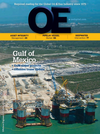
Page 59: of Offshore Engineer Magazine (Oct/Nov 2013)
Read this page in Pdf, Flash or Html5 edition of Oct/Nov 2013 Offshore Engineer Magazine
Production Eastern Trough Area Project on the North Sea Andrew platform, as contractors in place, and how we make central processing facility.
part of work to tie-in the Kinnoull oil sure there are enough suppliers in feld. However, in Andrew’s case, the place? Also, how do we then manage platform has been shut down. how we operate and maintain them in a consistent way? “This is not about fxing specifc
SOM projects
The next challenge is to achieve a equipment issues, but about creating sustainable operating mode on the a systematic model that identifes and facilities. proactively fxed gaps in the processes and systems to enable a long-term solu- “What has happened before is we, as tion, minimizing overall production an industry, keep doing the same thing losses and increasing reliability in the again and again, and expect different long term,” says Sandoval. results,” says Sandoval. “We cannot
In addition, SOM projects will look keep doing this, we need to fnd ways of at right-sizing and technical suit- doing things offshore differently. This is ability of facilities and aspects of where we need technology, such as R2S.
“We also need to revisit how we obsolescence. work,” he says. Specifcally, he wants done in specifc areas to realize a SOM work will also move into look- to look at how job functions could be SOM, such as valve maintenance and ing at the effectiveness of root-cause more fexible, so that one bed space procurement, rotating equipment, and failure analysis, risk and vulnerability occupant could fulfl multiple roles, controls and instrumentation, which management, personnel issues, and instead of working in silos. can then be duplicated geographically. plant criticality.
A program with the SOM appraisal “There are tens of thousands of valves Together, these initiatives aim not work will look at technology use, orga- offshore and they are crucial,” he says. only to renew the Magnus, ETAP, and nizational structure, recruitment and “Production losses can be down to other North Sea facilities, but also to reward strategy, leadership capability, valves. We decided how to look in to fnd better ways to maintain and sus- roles and responsibilities defnition, that common equipment type. tain facilities’ OE improvements and and clarifcation. “How do we defne what valves we service requirements, following a fotel
Sandoval also thinks more can be use, how we buy them, how we get or any other vessel intervention.
Lerwick Harbour is strategically located in supporting energy industries – oil and gas – onshore and in the northern North Sea and Atlantic.
With its twin entrances, 24-hour, all-weather access and modern infrastructure, the continuing development and diversification of the deep-water port includes accommodating the largest heavy construction ships and crane barges.
Full service base capability l
Over 1,300 metres of deep-water quays l
Extensive laydown, open storage & warehousing l
Dedicated decommissioning facilities l
Leading decommissioning contractors l
Sheltered anchorages l
Engineering & project support l
Total waste management, including recycling l
LERWICK PORT AUTHORITY
T +44 (0) 1595 692991 E [email protected] www.lerwick-harbour.co.uk oedigital.com October 2013 | OE 61 058_1013OE_ProdOps1BP.indd 61 9/29/13 10:08 PM

 58
58

 60
60